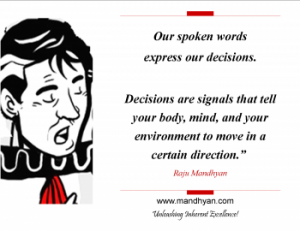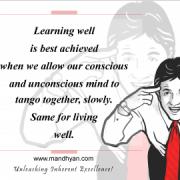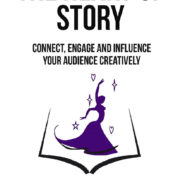Coaching & Neuro-semantics
Though the term neuro-semantics had been on my mental white-board for a while, it re-surfaced during a conversation with Professor Juno Parungao and Engineer Claude Sta Clara, of Mind Pool Inc, Philippines, and a few months ago. I have also, over the years, been professing the finer effects of language and words on human minds using Appreciative Inquiry‘s, “Our Words create our Worlds.”
The study of the words we choose, how we morph our sentences, what assumptions we unconsciously embed in our questions, and what kind of impact will they have on the people across me has become a living passion for me. It is powerful and meaningful because, yes, it does really create my world and re-design my future.
I have also been closely following David Rock’s work at the Neuroleadership Institute and I must confess that they are putting together some serious cutting edge theories and practices in the field of human development. David Rock also is master coach and his book, Coaching with the Brain in Mind, is a landmark in this field.
Last night I happened to come across a video of a Sample Coaching Session with David Rock and it is an insightful demonstration of a master at work. Yet being the curious student that I am I could not help noticing little things which can be improved in that demonstration and all coaching conversations. The video if you click through and watch it, you will realize that it was pre-planned and David’s role-play partner playing his “client” Kelly is a surely an experienced coach herself thus she played the client role skilfully and easily. All is well and good with that angle. Here are things that coaches, from the perspective of Neuro-semantics, can correct and improve upon keeping David & Kelly’s demonstration in mind.
 One: The usage of the word “issue.” Issue implies a problem and a conflict more than it implies a challenge or a goal. Any word with any amount of negativity or, even, an implication of negativity can leave behind abrasive residual impression on the mind, body and performance of the client. The same applies for the usage of the word “Deadline” as used in the demonstration. How about using “target date” instead of saying “dead-line?” I don’t want to get to close to line that is dead or a line that will lead to death.
One: The usage of the word “issue.” Issue implies a problem and a conflict more than it implies a challenge or a goal. Any word with any amount of negativity or, even, an implication of negativity can leave behind abrasive residual impression on the mind, body and performance of the client. The same applies for the usage of the word “Deadline” as used in the demonstration. How about using “target date” instead of saying “dead-line?” I don’t want to get to close to line that is dead or a line that will lead to death.
Two: A standard procedure to figure out the importance of a client’s goal is to have him rank it from ten to one. In most cases that should work along happily in assessing the value and the drive the client may have for that particular goal. Creative coaches and coaches who want to be Unleashers of Inherent Excellence rather than structured technicians will replace ranking for importance by simple “How important is that goal for you?” Or, something much more exploratory and open-ended like “Tell me how much you want that?”
This will allow the client to open up, think more, tell more and not blurt a logical sounding number to label a passion or a desire. Using descriptive words will fire away several extra neural synapses in the brain.
Three: I observed that even though it was obvious that Kelly and David know each other well and the rapport was obvious. I thought David needed to work up a little more calmness, presence and kinaesthetic grounding. This observation was much more prominent in the first two minutes of the conversation. When a coach generates and calls upon increased calmness, presence and kinaesthetic grounding he can lessen the edginess of starting up a new conversation. Unless, of course, the slight edginess, in the beginning by David, was part of his technique as a coach to do away with any possible nervousness on part of the client. The effect of an apparent edginess on part of the coach is tantamount to saying, “Hey, you are nervous? So am I!” It’s reverse mirroring, pacing and leading.
Other than that I thought the focus was great, the direction the conversation stayed was very good. The precision and the timing were awesome. And, I really loved the way these questions were placed and how they generated flow and empowerment.
Question One: “So how can best help you think this through?” Nice!
Question Two: “So what do you think you need to do?” Empowering!
Question Three: “Have you seen what you have to do next?” Powerful!
There you go!
For those not clear about neuro-semantics here is a quick description: The discipline explores how language works inside of us, how we create meaning by words, structure, associations, framing, metaphors, etc. It also explores how our bodies work with language and ideas to “realize” or “actualize” things and also how it influences our beliefs about the world and the future.
Or, better stated,
“Our spoken words express our decisions. Decisions are signals that tell your body, mind, and your environment to move in a certain direction.” Raju Mandhyan








I noticed that it’s hard to find your blog in google, i found it on 15th spot, you should get some quality backlinks to rank it in google and increase traffic. I had the same problem with my site, your should search in google for – insane google ranking boost – it helped me a lot